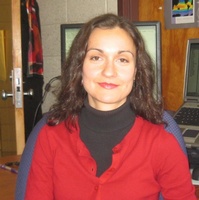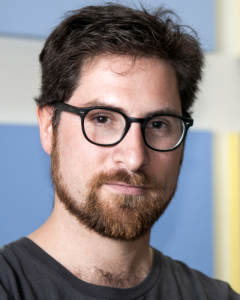Dr. Zoe Borovsky, UCLA Libraries (http://guides.library.ucla.edu/profile/zoe)

UCLA Libraries and the Research Commons
When the Research Library at UCLA opened the doors to its newly renovated spaces in September 2011, one of the most controversial aspects of the $17-million facelift was the future-oriented Research Commons an area that was designed to foster collaborative group work as envisioned by UCLAs librarians and digital humanities faculty. Just a month before this opening, I was hired as the Librarian for Digital Research and Scholarship and took on the role of providing the connection between those visions and the practical tasks of managing these technology-enhanced spaces. As a digital humanities researcher and newly-appointed librarian, I imagined the Research Commons as an area where librarians and humanities scholars could showcase the process of knowledge-production, with librarians as active partners in this process. Along these lines, my colleague at Stanford, Glen Worthey, recently askedWhat is all this traditional library work if not an engagement with how knowledge is made? And what are we [librarians], if not co-makers of that knowledge? Drawing on my experiences introducing network analysis to humanities scholars, I will present examples of the experiments, challenges, and successes of practicing digital humanities in a library over the past three years. I will reflect on the debates over the role of librarians doing digital humanities work and conclude with what I view as next steps and opportunities.
Prof. Elena Dimitrova, Clemson University (http://people.clemson.edu/~EDIMIT/)
Canalization in mathematical modeling
The concept of “canalisation” was introduced by the geneticist C.H. Waddington in 1942 to represent the ability of a genotype to produce the same phenotype regardless of environmental variability. Canalyzing functions, a particular class of Boolean functions, later found application in physics, engineering and biology. Variations on the idea of canalyzation have been explored in recent years and it has been demonstrated that Boolean functions with canalizing properties show stable dynamic behavior and are thus suitable as to express regulatory relationships in biochemical and other networks. However, in practice, relaxing the canalyzing requirement on some variables is appropriate. In this talk, I will introduce the class of partially nested canalyzing functions and discuss some of their properties and applications.
Wim Hugo
Beyond Meta-Data: Nano-Publications Recording Scientific Endeavour
The ICSU World Data System promotes access to quality-assured data and services for the benefit of scientists and the general public. As such, it invites data centres and global services to join on the basis of accreditation. Such accreditation covers most aspects of sustainable data centre or service operation, ranging from financial, scientific and technical governance to the extent of standards implementation, longer-term viability, community engagement, and so on.
ICSU-WDS sees itself as a critical contributor to an emerging Global Research Data Infrastructure – providing, with other major stakeholders such as DataCite, a knowledge network of registries that define our collective scientific effort – especially if it is government-funded. ICSU-WDS is especially well placed to solidify registries dealing with Trusted Digital Repositories and Services, the scope of data holdings and services offered by these, and their linkages to other aspects of science endeavor. The author will present a blueprint for such a Global Research Infrastructure, underpinned by a knowledge network. The design is strongly dependent on and aligned with existing and emerging resources.
To achieve this end, ICSU-WDS has initiated a programme to establish vital components that it can contribute to such a Global Knowledge Network – starting close to home by mining the meta-data contributed by its membership, together with the accreditation data supplied and maintained by them. Examples of early prototyping will be discussed, together with practical challenges of network complexity, size, and traversal/ visualization.
Linking such repository information to others that maintain permanent identifiers for similarly important components will be a next step: DataCite (linkages to citable data and publications), and ORCID (linkages to researchers and institutions) are obvious choices.
The major questions that require research and collaboration revolve around (1) mandate – for which working with the Research Data Alliance provides a good starting point; and (2) scalability – where we believe that a shift in focus from traditional approaches needs to be investigated. We envisage a gradual shift from formal repository maintenance as the only contributor to the knowledge network to multi-sourced nano-publication: the equivalent of ‘tweets about science’.
Apart from scientists, who stand to be the beneficiaries of such infrastructure, our concept will also greatly assist science funders by supplementing their understanding of past, current, and future endeavors in science.
Prof. Bettina Speckmann, TU Eindhoven ( http://www.win.tue.nl/~speckman/)
Geovisualization for library metadata
Today’s libraries provide online access to millions of bibliographic records. Librarians and researchers require tools that allow them to manage and understand these enormous data sets. Most libraries offer only textual interfaces for searching and browsing their holdings. The resulting lists are difficult to navigate and do not allow users to get a general overview. Visualizations provide a means to overcome these difficulties. Graphical representations provide quick access to bibliographic data, facilitate the browsing and identification of relevant metadata, and provide a quick overview of the coverage of libraries.
The fields of Information Visualization and Visual Analytics within Computer Science develop computer-supported, interactive, visual representations which allow users to extract meaning from large and heterogeneous data sets. While such visual techniques have become common practice in the sciences, they are little employed by libraries, despite similar increases in available data. In this talk I will (1) discuss the results of a recent collaboration between computer scientists and digital humanities scholars to create interactive geographic visualizations of library metadata and (2) present geovisualization techniques which might find application in digital humanities.
Dr. Vincent Traag, KITLV (http://kitlv.nl/researchers-traag/)
Discovering communities in networks
Many phenomena can be modeled as a network: articles citing other articles, webpages connected through hyperlinks or people calling each other. Often, these networks are rather large and difficult to understand. However, they usually exhibit some clustering, with some dense groups of nodes, usually called communities. Finding these communities helps us understand the structure of the network, and they often relate to other characteristics. For example, a community of well connected articles might indicate some specialisation within an academic field. I will provide an overview of methods for discovering such communities. Two core problems of these methods are highlighted and addressed: the so-called resolution limit and the significance of community structure. Only few methods do not suffer from the resolution limit and I will introduce one such method. The second problem will be addressed by studying subgraph probabilities. Interestingly, both problems seem to be incongruent, so that no method can address both problems simultaneously. I will discuss the implications for using community detection in research, and show how to avoid some of the pitfalls.
References
1. Traag, V. A., Krings, G. & Van Dooren, P. Significant scales in community detection. Scientific Reports 3, 2930 (2013). http://www.nature.com/srep/2013/131014/srep02930/full/srep02930.html
2. Traag, V. A., Van Dooren, P. & Nesterov, Y. Narrow scope for resolution-limit-free community detection. Physical Review E 84, 016114 (2011). http://link.aps.org/doi/10.1103/PhysRevE.84.016114





